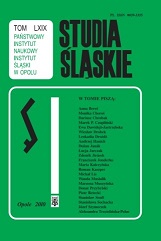Struktura morfologiczna małych miast Śląska Opolskiego w okresie transformacji ustrojowej (Ujazd i Korfantów)
The morphological structure of small towns in Opole Silesia in the time of the sociopolitical system transformation (Ujazd and Korfantów)
Author(s): Wiesław DrobekSubject(s): History
Published by: Instytut Śląski
Keywords: urban-architectonic space; physical dimension; symbolic dimension; sociopolitical system transformation;
Summary/Abstract: The paper aims to show the influence of the sociopolitical system transformation process on the morphological structure, in the sense of the urban-architectonic space (both in the physical and symbolic dimensions), of the two smallest towns (numbering below 2 thousand inhabitants) of Opole Province, that is Ujazd and Korfantów. Ujazd is one of the towns in Opole Silesia which has managed to maintain its civic rights uninterruptedly since the date of its foundation (1223), whereas Korfantów possessed the civic rights from the 14th century till 1742 and in the years 1867–1945, and did not regain them until 1993. Located in Strzelce County, Ujazd was inhabited in 90% by the local population after World War 2, while the community of Korfantów, belonging to Nysa County, formed as a result of population transfers after the War. Both places were assigned industrial and service providing functions towards the end of functioning of the Polish People’s Republic. The passage from the centrally-planned to free-market economy brought about numerous changes in them, including their urban-architectonic space. Direct transformations connected with the change in the ownership structure of subjects, liquidation of part of companies, undertaking business activity, manifested themselves – among others – in the form of decapitalization of some buildings, occupying areas designed for investment, setting up new objects of determined architectonic look. Indirect alterations, in turn, resulting from unemployment and the growing problem of social differentiation find their expression, among others, in the division into better and worse parts of the town, into uncared for tenement houses and newly-erected residences.
Journal: Studia Śląskie
- Issue Year: 2010
- Issue No: 69
- Page Range: 107-126
- Page Count: 30
- Language: Polish

